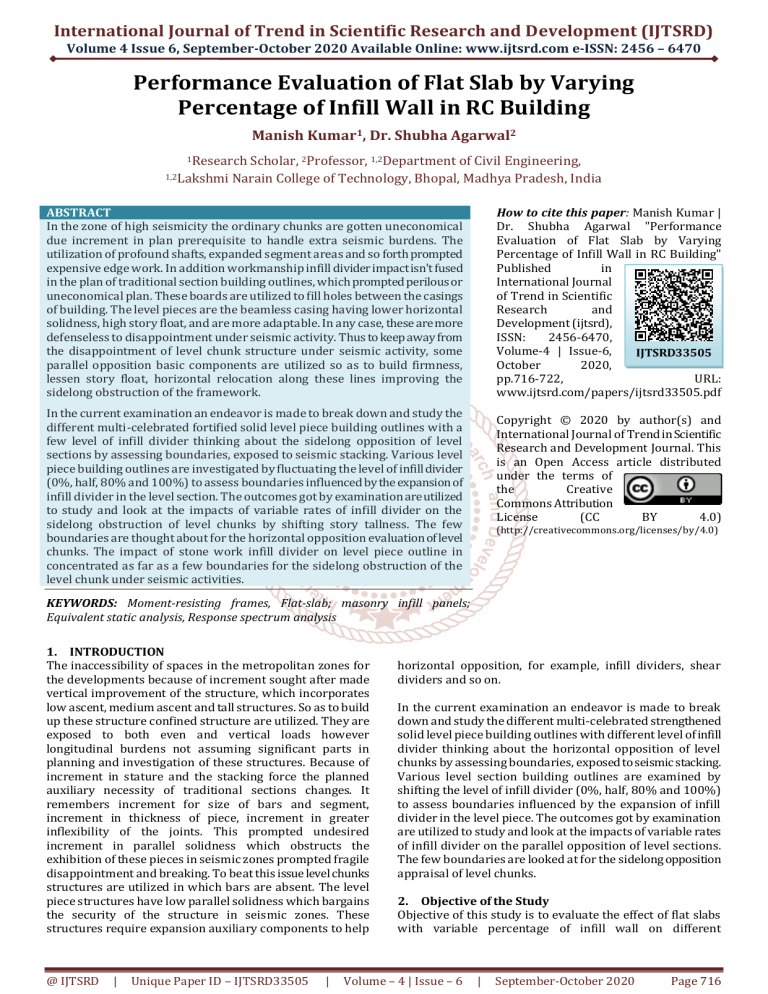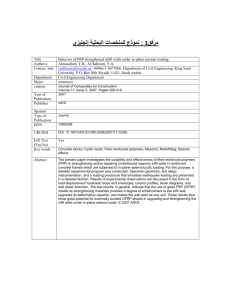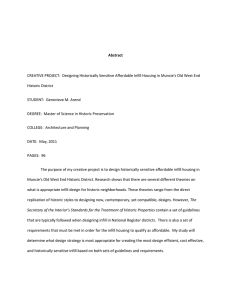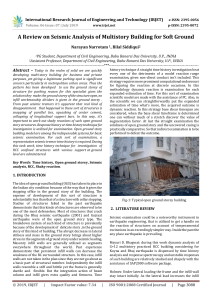
International Journal of Trend in Scientific Research and Development (IJTSRD)
Volume 4 Issue 6, September-October 2020 Available Online: www.ijtsrd.com e-ISSN: 2456 – 6470
Performance Evaluation of Flat Slab by Varying
Percentage of Infill Wall in RC Building
Manish Kumar1, Dr. Shubha Agarwal2
1Research
Scholar, 2Professor, 1,2Department of Civil Engineering,
1,2Lakshmi Narain College of Technology, Bhopal, Madhya Pradesh, India
ABSTRACT
In the zone of high seismicity the ordinary chunks are gotten uneconomical
due increment in plan prerequisite to handle extra seismic burdens. The
utilization of profound shafts, expanded segment areas and so forth prompted
expensive edge work. In addition workmanship infill divider impact isn't fused
in the plan of traditional section building outlines, which prompted perilous or
uneconomical plan. These boards are utilized to fill holes between the casings
of building. The level pieces are the beamless casing having lower horizontal
solidness, high story float, and are more adaptable. In any case, these are more
defenseless to disappointment under seismic activity. Thus to keep away from
the disappointment of level chunk structure under seismic activity, some
parallel opposition basic components are utilized so as to build firmness,
lessen story float, horizontal relocation along these lines improving the
sidelong obstruction of the framework.
How to cite this paper: Manish Kumar |
Dr. Shubha Agarwal "Performance
Evaluation of Flat Slab by Varying
Percentage of Infill Wall in RC Building"
Published
in
International Journal
of Trend in Scientific
Research
and
Development (ijtsrd),
ISSN:
2456-6470,
Volume-4 | Issue-6,
IJTSRD33505
October
2020,
pp.716-722,
URL:
www.ijtsrd.com/papers/ijtsrd33505.pdf
In the current examination an endeavor is made to break down and study the
different multi-celebrated fortified solid level piece building outlines with a
few level of infill divider thinking about the sidelong opposition of level
sections by assessing boundaries, exposed to seismic stacking. Various level
piece building outlines are investigated by fluctuating the level of infill divider
(0%, half, 80% and 100%) to assess boundaries influenced by the expansion of
infill divider in the level section. The outcomes got by examination are utilized
to study and look at the impacts of variable rates of infill divider on the
sidelong obstruction of level chunks by shifting story tallness. The few
boundaries are thought about for the horizontal opposition evaluation of level
chunks. The impact of stone work infill divider on level piece outline in
concentrated as far as a few boundaries for the sidelong obstruction of the
level chunk under seismic activities.
Copyright © 2020 by author(s) and
International Journal of Trend in Scientific
Research and Development Journal. This
is an Open Access article distributed
under the terms of
the
Creative
Commons Attribution
License
(CC
BY
4.0)
(http://creativecommons.org/licenses/by/4.0)
KEYWORDS: Moment-resisting frames, Flat-slab; masonry infill panels;
Equivalent static analysis, Response spectrum analysis
1. INTRODUCTION
The inaccessibility of spaces in the metropolitan zones for
the developments because of increment sought after made
vertical improvement of the structure, which incorporates
low ascent, medium ascent and tall structures. So as to build
up these structure confined structure are utilized. They are
exposed to both even and vertical loads however
longitudinal burdens not assuming significant parts in
planning and investigation of these structures. Because of
increment in stature and the stacking force the planned
auxiliary necessity of traditional sections changes. It
remembers increment for size of bars and segment,
increment in thickness of piece, increment in greater
inflexibility of the joints. This prompted undesired
increment in parallel solidness which obstructs the
exhibition of these pieces in seismic zones prompted fragile
disappointment and breaking. To beat this issue level chunks
structures are utilized in which bars are absent. The level
piece structures have low parallel solidness which bargains
the security of the structure in seismic zones. These
structures require expansion auxiliary components to help
@ IJTSRD
|
Unique Paper ID – IJTSRD33505
|
horizontal opposition, for example, infill dividers, shear
dividers and so on.
In the current examination an endeavor is made to break
down and study the different multi-celebrated strengthened
solid level piece building outlines with different level of infill
divider thinking about the horizontal opposition of level
chunks by assessing boundaries, exposed to seismic stacking.
Various level section building outlines are examined by
shifting the level of infill divider (0%, half, 80% and 100%)
to assess boundaries influenced by the expansion of infill
divider in the level piece. The outcomes got by examination
are utilized to study and look at the impacts of variable rates
of infill divider on the parallel opposition of level sections.
The few boundaries are looked at for the sidelong opposition
appraisal of level chunks.
2. Objective of the Study
Objective of this study is to evaluate the effect of flat slabs
with variable percentage of infill wall on different
Volume – 4 | Issue – 6
|
September-October 2020
Page 716
International Journal of Trend in Scientific Research and Development (IJTSRD) @ www.ijtsrd.com eISSN: 2456-6470
parameters by using seismic analysis. Following are the
parameters under consideration
Target of this examination is to assess the impact of level
sections with variable level of infill divider on various
boundaries by utilizing seismic investigation. Following are
the boundaries getting looked at
A. To assess the impact of level chunks with variable level
of infill divider on Lateral Load,
B. To assess the impact of level chunks with variable level
of infill divider on Story Shear,
C. To assess the impact of level sections with variable level
of infill divider on Lateral Displacements
D. To assess the impact of level pieces with variable level of
infill divider on Story Drift
E. To assess the impact of level chunks with variable level
of infill divider on Drift proportion
3. Literature Review
Luo et al. (1994) give an equivalent frame approach for
non-linear seismic analysis for RC flat plate building, based
on hysteretic model and concept of effective slab width. The
determination of the factor of effective slab width and
hysteretic parameters are evaluated from the response of
laboratory tests. The results of the elastic analysis can
deviate from the actual results based upon the assumed
stiffness reduction factor and effective slab-width. Kim et al
(2005) proposed method includes the development of super
elements for the study of flat slab system with the help of the
matrix condensation technique. The finite element method is
used in openings but takes more computation time. They
propose an analytical method using super element gives
good results with mesh results and reduces the computation
time. The stiffness degradation effect due to cracks is also
considered in the proposed method. Apostolska et al. (2008)
evaluated earthquake performance of a reinforced concrete
flat slab system with the help of different model includes
Frame, Flat-slab strengthened by perimeter beam and RC
walls, Purely flat-slab, Flat-slab strengthened by RC walls
and Flat-slab strengthened by a perimeter beam. They
observed that the fundamental period and displacements of
the flat-slab system is more in comparison to framed
systems. The modal vibration of the first mode is
characterized by torsion. Han et al. (2009) developed a
method for the slab stiffness reduction factor calculations in
beams width models for the estimation of moments and
lateral drifts for the flat slabs against the dynamic loading.
The nonlinear regression is conducted using data collected
from test results of reduction factors. Lateral load and slab
stiffness reduction factors both are different. It is observed
that the proposed technique with the stiffness reduction
factor correctly validates the estimation of the lateral
stiffness of the test model. Asteris et al. (2011) studied and
reviewed different modeling techniques for the modeling of
infill walls. They compared macro models for the infill
analysis from previous researches. They also conclude five
failure modes involved with infill walls interactions with
corresponding frames. The failure modes include corner
crushing, diagonal compression, sliding shear, diagonal
cracking and frame failure. Biswas et al. (2013) studied a
fifteen storey flat plate garments building with STAAD.pro,
for the different orientation of diagonal bracings and shear
wall. They studied the variation of lateral displacements and
axial load on columns with the storey height. They observed
that the lateral displacement is more in flat slabs without
@ IJTSRD
|
Unique Paper ID – IJTSRD33505
|
lateral resistance and minimum in exterior and middle shear
wall case. And as the height increases lateral displacement is
also increases. Agrawal et al. (2013) studied six storey
college building with RC frame for the different percentage
openings in the frames with infill walls. For this purpose
different models are analysied for dynamic analysis using
staad pro software a tool. For the modeling of infill walls
equivalent strut model are used. The various models
including bare frame, open ground storey frame complete
infill, open ground storey frame with 15% centre opening
and open ground storey Frame with 15% corner opening are
analysed to evaluate the parameters such as deflections,
axial force, moments etc. They observed that the deflection
in bare frame is more than infill frames and among the all
infill models deflection of center opening model is more than
corner opening model. The opening increment decreased the
lateral stiffness of infill frames. Mohana et al (2015) studied
the performance of Flat Slab and Conventional Slab Structure
during seismic activity using Etabs software for Different
Earthquake Zones. They modelled six storey commercial
building having flat slabs and conventional slabs and
analysed for various parameters including storey shear, axial
load, storey displacements and drift ratio. The analysis
results are compared and investigated. They observed that
when the seismic level increases the intensities of various
seismic parameters also increases. Gouramma et al (2015)
analytically investigated different types of concrete slabs for
the identification of seismic demand and performance level
using various approaches of analysis including linear as well
as nonlinear analysis. In this study different slab including
Conventional RC slab system, ribbed slab system, Flat slab
system, Flat slab with edge beam system and Flat slab with
shear wall system, are modeled and analysed by using
ETABS software as a tool. They observed that Base Shear is
more in flat slab with shear wall system as compare to all
models. The maximum drift for flat slab system is more
compare to conventional slab system, ribbed slab system,
flat slab with edge beam system and flat slab with shear wall
system in all seismic zones. Patwari et al (2016) studied
behaviour of flat slab building with shear wall and without
shear wall for different seismic parameters including time
period, base shear, storey displacement and storey drift. The
11 storey building model isanalysed by response spectrum
method of analysis using Etabs software along with different
shape and orientation of shear wall in flat slabs. They found
that the position and shape of lateral resisting system also
affect the parameters as for Structure with shear wall along
periphery have minimum Time period and minimum storey
displacements.
4. Methodology
To accomplish the targets of present examination the
Equivalent static investigation (ESA) and Response
Spectrum Analysis (RSA) are considered for the parametric
investigation of the level piece working with variable level of
infill divider. For the current investigation four unique
models of level piece with infill divider are thought of.Flat
slab with 0% infillwalls
A. Flat slab with 50% infill walls
B. Flat slab with 80% infill wall
C. Flat slab with 100% infill wall
The over four models is dissected for 10 story building. The
displaying and investigation are finished with the guide of
programming STAAD-PRO V8i in quiet submission with the
Volume – 4 | Issue – 6
|
September-October 2020
Page 717
International Journal of Trend in Scientific Research and Development (IJTSRD) @ www.ijtsrd.com eISSN: 2456-6470
codes IS: 456-2000 and IS: 1893-2002. The complete 4
models of level chunks with infill dividers for 10 story
building is examined by utilizing identical static
analysis(ESA) to get the seismic boundaries including story
shear, sidelong removal, story float, float proportion and
horizontal burden. The methodology worked out to achieve
objectives of the study is as follows:
A. Select a suitable flat slab building model of 10storeys.
B. Model the selected buildings of flat slabs with 0%, 50%,
80% and 100% infill walls.
C. Equivalent static analysis of the selected building
models and a comparative study on the parameters
obtained from the analyses to evaluate the effect of
percentage infill on the flat slab frames.
Storey
G+9
5. Modeling of Building Frames
Different 5 narrows by 5 straight multi celebrated RC level
piece outlines with various level of infill dividers are
examined according to Indian standard codes under seismic
stacking in limited component bundle STAAD Pro. The
arrangement measurement 25 m × 25 m and a story tallness
of 3.5 m each in all the floors. The structure is kept
symmetric in plan to evade torsional reaction under
horizontal power. The structure is thought to be in seismic
zone III according to May be: 1893 (Part 1) - 2002. To
accomplish the more summed up arrangement these
structure outlines are examined for different statures and for
different infill divider rates, saving different measurements
and properties same for keeping up consistency in the
structure outline models.
Table 3.1: Model description of flat slab building
Model Model designation
Description
1
FS
Flat Slab model with no infill walls
2
FS 50%
Flat Slab model with 50 % infill walls
3
FS 80%
Flat Slab model with 80 % infill walls
4
FS 100%
Flat Slab model with 100 % infill walls
The above 4 models are analyzed by equivalent static analysis and response spectrum analysis to parametrically evaluate the
effect of flat slab with different percentage of infill walls.
Figure 3.1: Isometric view of flat slab building having
no infill walls
Figure 3.3: Isometric view of flat slab building having
80 % infill wall
Figure 3.2: Isometric view of flat slab building having
50% infill walls
Figure 3.4: Isometric view of flat slab building having
100% infill wall
@ IJTSRD
|
Unique Paper ID – IJTSRD33505
|
Volume – 4 | Issue – 6
|
September-October 2020
Page 718
International Journal of Trend in Scientific Research and Development (IJTSRD) @ www.ijtsrd.com eISSN: 2456-6470
Table 3.2: Various parameters for seismic load calculation
S. No.
Parameters
value
1
Seismic zone
III
2
Response reduction factor
3
3
Importance factor
1.5
4
Soil site factor
2 (medium soil)
5
Damping ratio
0.05
6
Type of Structures
1
6. Result and Discussions
The static seismic analysis is performed for all models and in the following section results are discussed.
6.1. Lateral load
Comparison of lateral load at different story for flat slabs with 0 % (FS), 50 %( FS 50%), 80 %( FS 80%) and 100 %( FS100%)
infill walls models for 10 storey building are shown in Fig4.1.
Figure 4.1: Lateral load (kN) at different story for four models for 10 storey building
Fig 4.1 shows that FS 100% infill divider has greatest sidelong burden when contrasted with lower rates of infill. Horizontal
burden for FS 100% for the popular narrative for 10 story building is 1.29 occasions the level section with no infill model.
Parallel burden for FS80% is 1.26 occasions and for FS50% it is 1.16 occasions when contrasted with no infill case and
horizontal burden for all models increment from base and most extreme at popular narrative.
6.2. Storey shear
Comparison of storey shear at different story for flat slabs with 0 % (FS), 50 %( FS 50%), 80 %( FS 80%) and 100 %( FS100%)
infill walls models for 10 storey building are shown in Fig 4.2.
Figure 4.2: Storey shear (kN) at different story for four models for 10 storey building
@ IJTSRD
|
Unique Paper ID – IJTSRD33505
|
Volume – 4 | Issue – 6
|
September-October 2020
Page 719
International Journal of Trend in Scientific Research and Development (IJTSRD) @ www.ijtsrd.com eISSN: 2456-6470
Fig 4.2 indicates that storey shear for FS 100% for the bottom storey for 10 storey building in is 1.44 times the flat slab with no
infill model. Storey shear for FS80% is 1.35 times and for FS50% is 1.25 times the no infill case and storey shear for all models
increase from top and maximum at bottom storey i.e. at base.
6.3. Lateral displacement
Comparison of lateral displacement at different story for flat slabs with 0% (FS), 50 %( FS 50%), 80 %( FS 80%) and 100 %(
FS100%) infill walls models for 10 storey building are shown in Fig 4.3.
Figure 4.3: Lateral displacement (mm) at different story for four models for 10 storey building
Fig 4.3 demonstrates that horizontal removal for FS no infill model for the popular narrative for 10 story building is 25.8times
the level piece with 100% infill model. Horizontal Displacement for FS80% is 1.27 occasions and for FS50% is 1.87 occasions
the 100% infill case and parallel uprooting for all models increment from base and greatest at popular narrative.
6.4. Storey drift
Comparison of storey drift at different story for flat slabs with 0% (FS), 50 %( FS 50%), 80 %( FS 80%) and 100 %infill walls
models 10 storey building are shown in Fig4.4.
Figure4.4: Storey drifts (mm) at different story for four models for 10 storey building
Fig4.4 shows that story float for FS no infill model for the popular narrative of 10 story building is 31.7 occasions the level
section with 100% infill model. Story float for FS80% is 1.19 occasions and for FS50% is 2.07 occasions the 100% infill case for
popular narrative and story float for level piece with no infill case follows more non direct conduct than other infill case.
6.5. Driftratio
Comparison of drift ratio at different story for flat slabs with 0% (FS), 50 %( FS 50%), 80
%( FS 80%) and 100 %( FS100%) infill walls models 10 storey building are shown in Fig 4.5.
@ IJTSRD
|
Unique Paper ID – IJTSRD33505
|
Volume – 4 | Issue – 6
|
September-October 2020
Page 720
International Journal of Trend in Scientific Research and Development (IJTSRD) @ www.ijtsrd.com eISSN: 2456-6470
Figure 4.5: Drift ratio at different story for four models for 10 storey building
Fig 4.5 shows that float proportion for FS no infill model for the popular narrative of 10 story building is 31.776 occasions the
level piece with 100% infill model. Float proportion for FS80% is 1.19 occasions and for FS50% is 2.08 occasions the 100% infill
case for popular narrative and float proportion for level piece with no infill case follows more non direct conduct than other infill
case.
7. CONCLUSION
Fig 4.5 shows that float proportion for FS no infill model for
the popular narrative of 10 story building is 31.776
occasions the level piece with 100% infill model. Float
proportion for FS80% is 1.19 occasions and for FS50% is
2.08 occasions the 100% infill case for popular narrative and
float proportion for level piece with no infill case follows
more non direct conduct than other infill case.
7.1. Lateral load
The lateral load of flat slab with 100% infill wall has
maximum value as compared to 80, 50 and zero percentage
infill in 10 storey building. The infill wall addition increases
the overall weight of structure which increases the lateral
loads. The lateral load increases from base and maximum at
the top storey.
7.2. Story shear
The story shear for level piece with 100% infill divider has
greatest incentive when contrasted with 80, 50 and 0 % infill
in 10 story building. The story shear increments from top
and most extreme at base story for example at base.
7.3. Horizontal uprooting
The horizontal uprooting for level chunk with no infill
dividers at the popular narrative has greatest worth when
contrasted with 100, 80 and 50 rate infill in 10 story
building. The infill divider expansion expands the firmness of
the level section building. The sidelong relocation increment
from base and greatest at popular narrative.
7.4. Story float
The story float for level section with no infill divider at the
popular narrative has greatest worth when contrasted with
other rate infill models of level pieces in 10 story building.
The story float for level piece with no infill case follows more
non direct conduct than 100% infill case because of absence
of sidelong solidness.
@ IJTSRD
|
Unique Paper ID – IJTSRD33505
|
7.5. Float proportion
The float proportion for level piece with 0% infill model for
the popular narrative model has greatest worth when
contrasted with other rate infill models of level sections in
10 story building. The float proportion for level section with
no infill case follows more non direct conduct than other
infill case.
8. References
[1] Abdelaziz, M. M., Gomma, M. S., Ghazaly H. E.
(2019)."Seismic assessment of strengthened solid
structures infilled with brick work infill dividers",
Asian
J
CivEng
20,
961–981
https://doi.org/10.1007/s42107-019-00158-6.
[2] Agrawal, N., Kulkarni, P. B. what's more, Raut, P.
(2013)."Analysis of Masonry In filled R. C. Frame with
and without Opening Including Soft Story by utilizing
Equivalent Diagonal Strut Method", International
Journal of Scientific and Research Publications, Volume
3, Issue 9, September.
[3] Apostolska, R. P., Necevska-Cvetanovska, G. S.,
Cvetanovska, J. P. what's more, Mircic, N. (2008).
"Seismic execution of level piece building auxiliary
frameworks", the fourteenth World Conference on
Earthquake Engineering, Beijing, China.
[4] Asteris, P.G., Antoniou, S. T., Sophianopoulos, D. S.
furthermore,
Chrysostomou,
C.
Z.
(2011).
"Mathematical Macro modeling of In filled Frames:
State of the Art", Journal of Structural Engineering,
137(12): 1508-1517. DOI: 10.1061/ (ASCE) ST.1943541X.0000384.
[5] Bhatt, S. furthermore, Narayan, K. (2018)."Parametric
Study of Conventional Slab and Flat Slab in a Multi
Story RC Building", International Journal of
Engineering Research in Mechanical and Civil
Engineering Vol 3, Issue 5, May ISSN (Online) 24561290.
Volume – 4 | Issue – 6
|
September-October 2020
Page 721
International Journal of Trend in Scientific Research and Development (IJTSRD) @ www.ijtsrd.com eISSN: 2456-6470
[6] Biswas, R. K., Uddin, M. M., Chowdhury, M .A.
furthermore, Khan, A. I. (2013)."Comparative Analysis
of a 15 Story Flat Plate Building with and Without
Shear Wall and Diagonal Bracing Under Wind and
Seismic Loads", IOSR Journal of Mechanical and Civil
Engineering Volume 9, Issue 2 (Sep. - Oct.), PP 97-101.
[7] Blasi, G., Perrone,G. furthermore, Aiello, M. A.
(2020),"Influence of the Modeling Approach on the
Failure Modes of RC Iinfilled Frames Under Seismic
Actions", Proceedings of Italian Concrete Days 2018
LNCE 42, pp 69-89.
[8] Chandel, V. S. furthermore, Sreevalli, I. Y.
(2019)."Numerical examination on impact of stone
work infill in a RC outline", Asian J CivEng 20, 1–8
https://doi.org/10.1007/s42107-018-0083-7.
[9] Mohana, H. S. also, Kavan, M. R. (2015)."Comparative
Study of Flat Slab and Conventional Slab Structure
Using ETABS for Different Earthquake Zones of India",
International Research Journal of Engineering and
Technology (IRJET) e-ISSN: 2395-0056 Volume: 02
Issue: 03 | June p-ISSN: 2395- 0072.
[10] Muralidhara,
G.
B.
also,
Swathi,
K.
S.(2016)."Behavioural Study of RC Flat Plate MultiStory Building Persuaded by Stiffness of Masonry Infill
Wall", Int. Diary of Engineering Research and
Applications, ISSN: 2248-9622, Vol. 6, Issue 2, (Part - 4)
February, page no106-110.
@ IJTSRD
|
Unique Paper ID – IJTSRD33505
|
[11] Navyashree, K. also, Sahana, T. S. (2014)."Use of Flat
Slabs in Multi-Story Commercial Building Situated in
High Seismic Zone", International Journal of Research
in Engineering and Technology Volume: 03 Issue: 08
eISSN: 2319-1163 pISSN: 2321-7308.
[12] Patwari, K. also, Kalurkar, L. G.(2016)."Comparative
Study of Flat Slab Building with and Without Shear
[13] Divider to tremor Performance", International Journal
of Scientific Development and Research Volume 1,
Issue 6 June ISSN: 2455-2631.
[14] Sen, S. also, Singh, Y. (2016)."Displacement-based
seismic plan of level chunk shear divider structures",
Earthquake Engineering and Engineering Vibration, 15:
209-221.
[15] Shendkar, M. also, Ramancharla, P.K. (2018) ."
Response Reduction Factor of RC confined structures
with Semi-interlocked stone work and unreinforced
workmanship infill", ICI Journal, Volume: OctoberDecember: 1-6.
[16] Soni, P. K., Dubey, S. K. also, Sangamnerkar, P.
(2019)."Response Quantities of Framed Buildings under
Dynamic Excitation", International Journal of Innovative
Technology and Exploring Engineering, Volume-8 Issue11,
September
SSN:
2278-3075
DOI:10.35940/ijitee.K2192.098119.
Volume – 4 | Issue – 6
|
September-October 2020
Page 722



